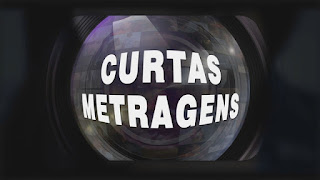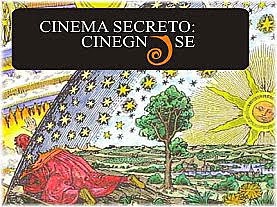A cinematographic project produced by a
couple, who shot the film in their own apartment in Toronto, Canada. Along with
their little daughter, a real family acts as a fictional family in a so-called
“Found Footage” film... (using video footage that appears to be real), found
and attached as evidence of a crime investigation. But this is a simplistic
synopsis (only one version) of the film Luciferous (2015) where a real family
is manipulated by a supernatural force that appears to exist in their
apartment, one that slowly tears the family apart. The film explores classic
Gnostic topics such as paranoia, memory and confusion between illusion and
reality... turning both actors and film viewers into detectives who try to
understand the false clues and strange metalanguages throughout the film. As is
the case for the contemporary archetype of the Detective, the act of solving
the puzzle can lead to an attack on the detective himself, the one who tries to
seek the truth. The film was suggested by our reader Felipe Resende.
After the film The Blair Witch Project (1999) the Terror
sub-genre “Found Footage” flourished and branched out into Sci-fi productions
like Cloverfield (2008) or the Horror franchise Paranormal Activity
(2007)... And then into real-time Terror variations such as the Uruguayan film La
Casa Muda: The Silent House (2010) - for more information about this film click here.
Throughout film history, Horror and Terror genres have been based on
the scopic pleasure inherent in observation: Voyeurism and Exhibitionism.
Traditional Terror narratives were ultimately exhausted, fading away by the end
of the last century as “slasher” movies and serial killings perpetrated by
Freddy Krueger and Jason made the public’s perverse pleasure explicit. Movies
such as The Cabin in the Woods (2011) deconstructed this pleasure – for
more information about the film click here.
This “Found Footage” sub-genre brought in a wave of renewal, offering
the public an alibi and excuse to relieve itself of the guilt of having such
perverse pleasures: Now we could watch "real cases” featuring videos
captured by hidden cameras, that objectively witness events that really occur.
Thus, we are no longer spectators whose pleasure it is in knowing, before the
protagonist, their cruel final destiny. In this “Found Footage” sub- genre, we
are as lost as the lead-characters and thus cleansed of any sin, because we are
mere eyewitnesses to a real event.
Luciferous (2015) takes this new alibi seen in the current Horror genre to
extreme radicalism: We see a real family (characters
in the film are family members in real life) produce and direct the footage
being witnessed. In addition, we then see a surprising (twist-ending) final
metalanguage, preceded by an hour-and-a-half viewing experience, in the best
style akin to The Sixth Sense (1999).
As discussed below, by creating this final metalanguage (the film
leaves metalinguistic clues throughout the narrative) Luciferous exposes
the secret pleasure enjoyed by the viewer and masked by the “Found Footage”
alibi. In the end, the puzzle that the viewer wants to unravel, along with the
lead-characters, reflects back onto the viewer himself. Luciferous
explores the Gnostic contemporary archetype of the Detective film: The riddle
of paranoia, which ultimately reverses against itself, and turns upon the one
trying to solve it.
The Film
Alex (Alexander Gorelick) and Mahsa (Mahsa Ghorbankarimi) enjoy a happy
life with their daughter Mina (Mina Gorelick) being the
centre of their world. Although the family struggles with some professional
challenges, they do everything they can to create happy memories for Mina,
recording them in photos and videos, even giving their daughter a small digital
camera with which to do the same.
But gradually strange things begin to happen, and the opening epigraph
taken from the film The Exorcist (1973) seems to prepare us for the
worst: "The demon is a liar. He will lie to confuse us. But he will also
mix lies with the truth to attack us. His attack is psychological and
powerful".
While the family sleeps, we see a picture fall off the wall, and an
empty chair slowly spins. We learn that Alex is tormented by guilt over the death
of his friend Peter who died in a car accident: Alex was the driver of the car
and blames himself for it.
And then, one day while on a run through the woods, Alex is brutally
hit in the head by something or someone, leaving him in a coma for a month, and
ultimately under his wife’s care in the family apartment. After Alex regains
consciousness, everything begins to change. During the day things seem to be
fine, but at night it seems that the kingdom of darkness dominates the house.
From out of nowhere a violent explosion wakes everyone. Mina stands eerily in
the middle of her room, screaming as toys fall.
The pet rabbit Fluffy, is found dead in Mina’s bedroom closet. Alex and
Mahsa begin to argue often. Alex becomes unpredictable and almost violent. When
driving the car, he becomes a threat to everyone. Mina blames her father for
the death of her rabbit, making Alex doubt his sanity: Could his behaviour be
due to a neurological injury?
The drugs prescribed by doctors only exaggerate his paranoid state,
making him believe that everything happening is a vengeful act caused by the
ghost of his friend Peter. All around, sanity seems to slip away and the
perfect family ceases to be happy.
Through images captured by the alleged hidden cameras, we realize that
during the night, and also later during the day, there is in fact some strange
presence that moves around the apartment, who seems to observe all and follow
everyone. But everything is fragmented and strangely edited in the film,
deliberately raising the fundamental ambiguity of the narrative: What, after
all, are we witnessing - a “Found Footage” or traditional “Live Action” version
of a conventional horror film?
Gnostic Paranoia and the Detective
Paranoia and confusion between fiction and reality (could all of this
have been caused by Alex's injury?) takes hold of the film’s lead-characters
and of the viewer.
Paranoia that leads to confusion between fiction and reality is a Gnostic theme par excellence. It refers to Valentinus (a Gnostic philosopher of the early Christian era) for whom the radical mistrust of the consistency of reality could lead both to enlightenment and madness.
Paranoia that leads to confusion between fiction and reality is a Gnostic theme par excellence. It refers to Valentinus (a Gnostic philosopher of the early Christian era) for whom the radical mistrust of the consistency of reality could lead both to enlightenment and madness.
In the gallery of contemporary archetypes it refers to the Detective
figure: One who is confronted by a puzzle and who tries to pick up the pieces
of a world that is falling apart. But in the end, that puzzle turns against
him, only to reveal some inner truth hidden by the illusions of the ego.
The fragmentary narrative and strange metalinguistic clues mirrored by
the film (for example, the skipping of frames in some sequences) present an
enigma to the audience: After all, what is the real "tone" of this story?
Is it “Found Footage”? Traditional “Live Action”? Is there any supernatural
entity in the apartment? Or are Alex’s hallucinations merely produced by
psychotropic prescriptions?
Alex tries to find some sanity in all of this by developing a kind of
metalanguage for himself: In his Vlog (Video Blog) he shares his personal
impressions in an attempt to understand the situation. Ironically, for Alex,
reality becomes an illusion, and the only real element is the recorded image of
himself videotaped in his personal blog.
The family filmed the project in their own apartment in Toronto,
Canada. In real life Alex is an expert in Stop-Motion productions and is of
Jewish background from the former Soviet Union. Mahsa, who was born in Tehran,
Iran, works in Photography, CG Lighting and Compositing.
A perfect chemistry
The curious thing is that the real décor of the apartment (featuring
masks, statues and paintings with religious, tribal and mythological motifs)
further helps to create the mysterious atmosphere of a cursed apartment,
opening the door to the possibly of the existence of a ghost or poltergeist.
There are no special effects here, other than some photographic edits that
suggest eerie uneasiness.
These visual artifacts change the imagery just enough to increase the
intensity of feelings of anxiety and paranoia. There is little use of music,
and the audio design is tempered and discreet.
This combination of reality and fiction (the real family that plays a
fictional family) creates a perfect chemistry, giving a sense of authenticity
that is difficult to find in the recent crop of films within the Horror
sub-genre.
The narrative, simultaneously slow and fragmented, seems to boil and
cook the family drama as they progressively lose the veneer of normalcy and
happiness. And in the end, the puzzle is exposed to the viewer: Both the
lead-characters in the film and the audience witnessing it are Detectives,
trying to solve the mystery of why ‘Man’ himself is most terrifying.
Sheet Film |
Title: Luciferous
|
Directors: Masha Ghorbankarimi, Alexander Gorelick
|
Writers:
|
Cast:
|
Production Co: Alexander Films
|
Distributors: Factory Film Studio
|
Year: 2016
|
Country:
Canada
|

 domingo, junho 26, 2016
domingo, junho 26, 2016
 Wilson Roberto Vieira Ferreira
Wilson Roberto Vieira Ferreira





 Posted in:
Posted in: 



![Bombas Semióticas na Guerra Híbrida Brasileira (2013-2016): Por que aquilo deu nisso? por [Wilson Roberto Vieira Ferreira]](https://m.media-amazon.com/images/I/41OVdKuGcML.jpg)
















